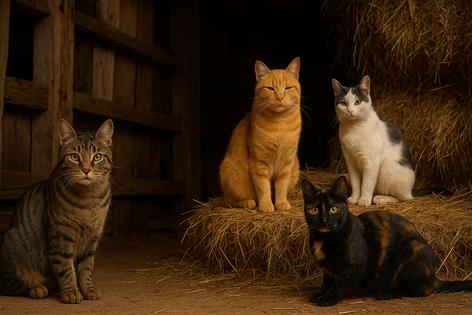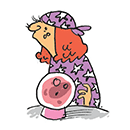Barn Cats: The Working Felines Who Earn Their Keep
Published in Cats & Dogs News
In a quiet field or behind a weathered stable, a flash of movement catches the eye—a lithe, watchful cat slipping between hay bales. These are barn cats, the self-appointed guardians of rural life. Long before the age of plush cat beds and Instagram fame, cats like these lived outdoors, patrolling farms and granaries, earning their meals by keeping the rodent population under control.
Though they share the same ancestry as their indoor cousins, barn cats are a different breed in spirit and behavior—half-wild, half-domesticated, bound by instinct as much as by companionship.
From Pharaohs to Feed Barns
The barn cat’s lineage stretches back thousands of years to the first agricultural settlements along the Nile and the Tigris. When humans began storing grain, rodents followed, and cats followed the rodents. This partnership was never truly ownership; it was a truce based on mutual benefit.
Modern barn cats carry that legacy. They are not pets in the traditional sense—they’re employees. On farms and ranches, they help protect feed stores from mice, rats, and even snakes. Many farmers consider them as essential as the tractor or the fence line.
The symbiosis remains simple: the cat gets food and shelter; the farmer gets pest control. Yet unlike pampered house cats, barn cats live in a world that tests their instincts daily.
Self-Reliant and Street-Smart
Barn cats are the ultimate problem solvers. They navigate unpredictable weather, evade predators, and hunt for survival. They learn to read the rhythms of human activity—when the milking starts, when the feed bins open, when the dogs are asleep.
Because they live semi-wild, their social structures resemble small colonies more than family units. A dominant female often emerges as the matriarch, raising kittens communally with help from other females. Tomcats drift in and out, driven more by instinct than loyalty.
By contrast, indoor cats exist in a controlled environment where meals, warmth, and medical care are guaranteed. Their days are dictated by the clock and the human schedule. A barn cat’s day, by comparison, is one of constant adaptation—quiet, alert, never fully off duty.
Diet and Hunting Behavior
Indoor cats depend entirely on their owners for food—carefully measured kibble, fresh water, maybe the occasional treat. Barn cats, on the other hand, live on a hybrid diet: part hand-fed, part hunted. Farmers often supplement their meals to ensure health and loyalty, but the cats do much of their own foraging.
They’re opportunistic predators, taking down mice, voles, and sometimes small birds. A good barn cat is a steady hunter, not a reckless one—it conserves energy, striking only when success seems certain. Watching one at work is like observing a small panther at the edge of a field, every movement measured and economical.
This hunting lifestyle keeps barn cats lean and muscular. Their coats tend to be thicker and coarser, adapted to the elements. Their whiskers grow long, helping them sense obstacles in dim light. And while indoor cats can go their entire lives without using their claws in earnest, barn cats rely on theirs daily.
Health and Hardship
Life outdoors takes a toll. Without vaccinations and regular veterinary care, barn cats face risks from disease, parasites, and injury. Feral-born cats are particularly vulnerable to respiratory infections and feline leukemia.
Responsible farmers now see veterinary care as part of the bargain. Many rural shelters run “barn cat” programs, adopting out sterilized, vaccinated cats that can live free while keeping barns rodent-free. These programs help control feral populations while preserving the old working-cat tradition.
Even so, the average barn cat’s lifespan—five to eight years—is shorter than that of an indoor cat, which can easily reach fifteen or more. Harsh winters, predators, and vehicles all pose threats. Yet many farmers argue that barn cats live fuller, more natural lives, free from confinement and boredom.
Personalities Forged by Environment
Environment shapes temperament. Barn cats are wary by default—cautious but curious. They may accept food or a gentle word from humans, but they rarely seek constant affection. Trust must be earned over time, and even then, it’s on their terms.
Indoor cats, surrounded by predictable comforts, often develop strong attachments to their humans and routines. They express their personalities within the boundaries of safety: playful, mischievous, occasionally aloof but fundamentally secure.
A barn cat’s affection, when it comes, carries a different weight. A soft head bump or a slow blink from a semi-wild cat can feel like a benediction—the acknowledgment of a fragile alliance.
Bridging Two Worlds
There are cats who live somewhere between the barn and the living room—part-time hunters who return indoors at night. These hybrids often embody the best of both worlds: skilled mousers, yet socialized enough to enjoy a warm lap.
Some farmers allow their barn cats gradual access indoors, especially in bad weather or old age. Others build insulated shelters with straw, heat lamps, or old blankets. The line between “working cat” and “family member” blurs easily; it’s hard not to care for a creature that keeps watch over your grain and greets you each morning.
The Future of the Working Cat
Automation has changed nearly everything about agriculture—but not the need for a good mouser. Despite electronic traps and sonic deterrents, farmers still rely on their feline employees. The barn cat remains one of the few traditional solutions that technology hasn’t improved upon.
Animal rescues continue to place sterilized feral cats in barns, warehouses, and greenhouses. These placements give unsocialized cats a purpose and a safe home while reducing unwanted litters. The practice represents a rare win-win for humans, animals, and ecosystems alike.
In a way, barn cats embody an ancient balance: independence and partnership, utility and affection. They remind us that coexistence doesn’t always require ownership.
Different, but Equally Beloved
Whether curled on a windowsill or stalking through straw, cats of every kind still hold the same mysterious magnetism. Indoor cats have comfort, companionship, and long lives. Barn cats have freedom, skill, and purpose.
They are two expressions of the same animal—one refined by civilization, the other tempered by nature. Both are remarkable in their own right, and both connect us to something older than technology: the quiet understanding between species who have shared hearths and harvests for nearly ten thousand years.
So when you glimpse that fleeting shape in the barn rafters, know that you’re seeing a living heirloom—one who doesn’t just survive but still, in its own way, rules the farm.
========
This article was written, in part, utilizing AI tools.









Comments